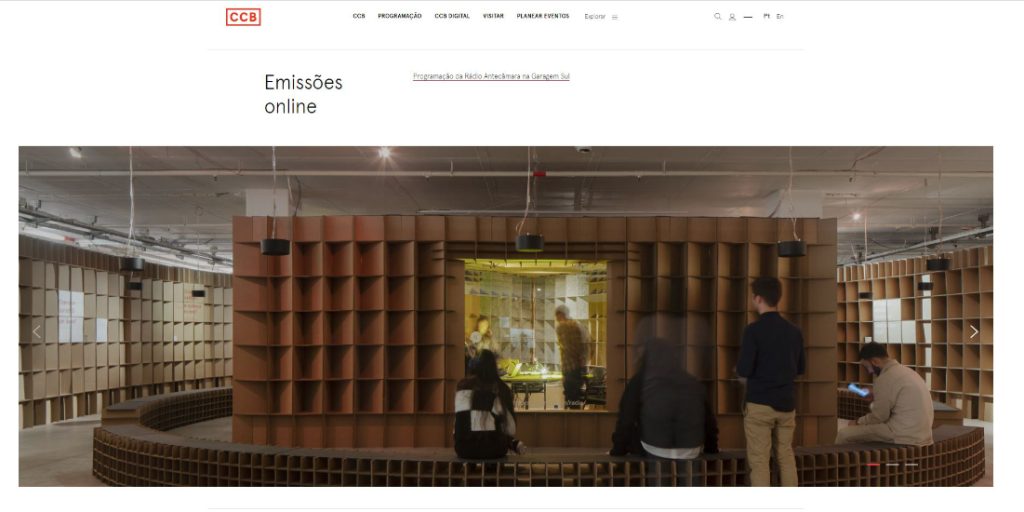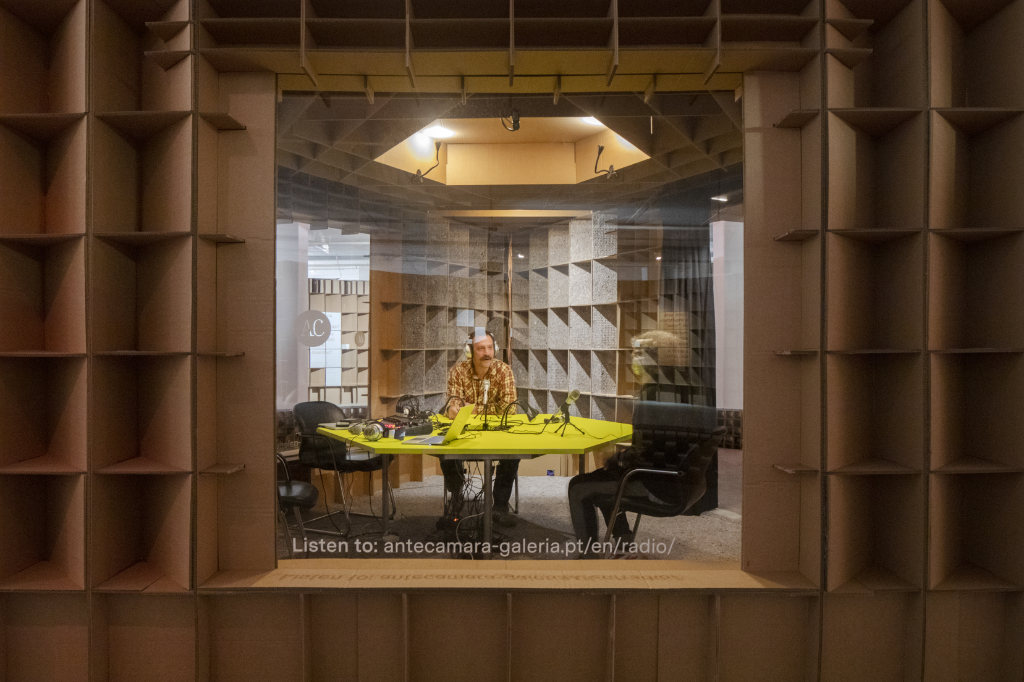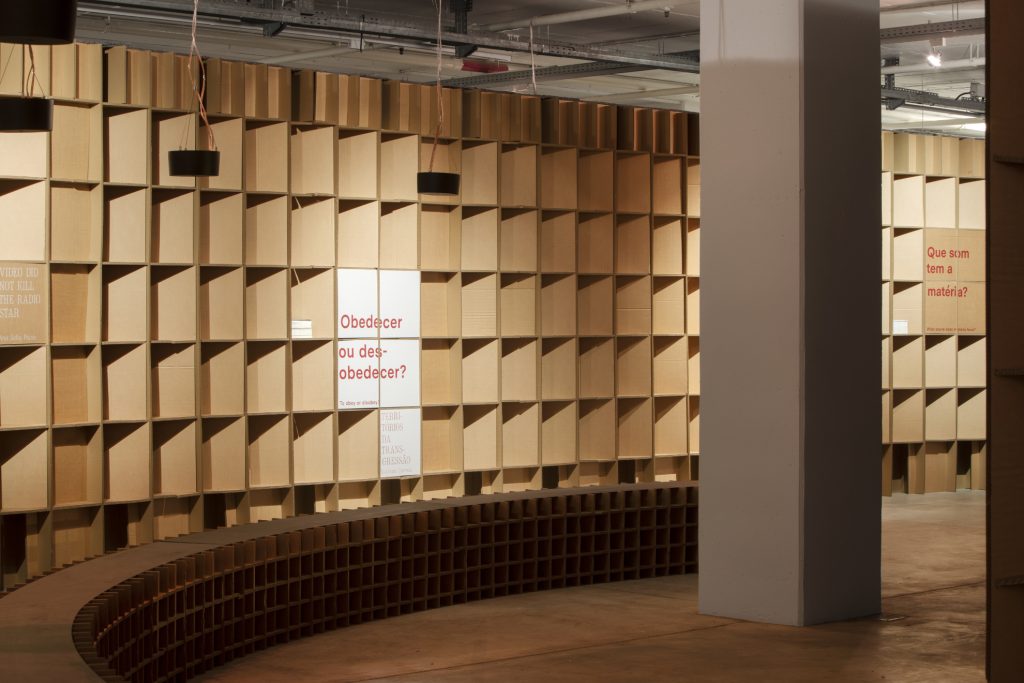Interview by Daniela Silva

An architecture studio that wanted to open up to the street and the neighbourhood: that’s how Antecâmara was born. The studio Campos Costa Arquitetos has rehabilitated an old bakery, where the interior was left to the architecture studio, and the Antecâmara gallery and radio are at the front, facing the street, where bread used to be sold, on a corner ground floor.
In August 2020, Antecâmara Radio turned on its microphones for the first time. It presents itself as the first architecture radio station in Portugal and is a digital station with podcasts dedicated to the discipline of architecture. Despite the pandemic limitations, the Antecâmara has not stopped: there are already six exhibitions and more than 50 radio broadcasts, some more around architecture and the city, others more exploratory.
Antecâmara Radio was launched on World Radio Day, curated by the architect Pedro Campos Costa. For the author, the need to create a radio that edits architectural content to question and expand notions about the city is fundamental. Campos Costa explains that the project intends that architecture will once again focus on the city through the media, opening new spaces for creation and empowerment for the class and the community. Antecâmara Radio uses Hertzian waves and digital circuits to create new perspectives on the built environment, challenging and expanding its meaning. Antecâmara radio examines our time through discussions between architects, artists, and designers and conversations with poets and landscape architects interspersed with sound and music interludes.
Alessia Allegri is the curator of the Sound It exhibition, Antecâmara radio and a member of the Antechamber Association. The exhibition “Sound it” explores how sound constructs and modifies spatial perception and experience by displaying this auditory component of space. It’s a personal trip to uncover an unseen architecture, an acoustically experienced space, and an audible and emotional location. An elliptical path leads us to some “sensed” regions around the studio’s performative and inhabited space. Moving around the ellipse becomes a pure acoustic experience, reminding us that our environment is made up of more than just walls. Sound is one of those spatial materials that we can’t see but can feel.



Antecâmara Radio is an edition of architectural content that uses sound space. What is the purpose of the project? Why is it important to bring architecture to the radio?
Pedro Campos Costa: Architecture needs mediation. Not only inside the discipline but also in the communities, society, and urban culture. The radio is another type of media that can do this mediation. Probably the most interesting of this project is the absence of images. I know it is very anti-intuitive to use radio to communicate a spatial art like architecture. And this is quite strange, at least unusual, especially in an exhibition space dedicated to architecture, where we are used to seeing drawings, models, and images. But you know, the sound obliges another type of focus and liberates the architecture of creating images. The sound creates images, but we cannot control them; each one that listens creates its images. We have amazing examples like “Vertigens das listas” or “Tela habitada” that we had comments that told us when to see the building or make a trip to see architecture after the program. The curiosity was so great that they started looking for it.
Alessia Allegri: Sound is also matter. You can’t see it, but you can feel it. It stimulates our physical awareness. And that is why sound constructs and shapes spatial perception and experience. Sound deepens the perceptual and emotional dimensions that a space can offer us beyond the visual size. The result is an invisible architecture, a space perceived through sound. And that is why we say that everyone creates his own image, his own imagined space.
PCC: But the main reason why we did this project is the importance of the transdisciplinary in architecture. The Radio allows it effortlessly. I like this idea that you can relate most easily when you lose your power (creation of images and drawings, and visuals). We gain privacy, and an interior talk can be started. I would say that this is the purpose of the Antecâmara, to create a physical or virtual space that allows a multidisciplinary, heterogeneous look for the core of architecture discipline.- Architecture is naturally a discipline that deals with many other disciplines.
AA: Another topic that interests us very much is the importance of the “word”, the spoken word, and the slow tempo of the word. We live in constant acceleration, in which the “scroll” of the images is what we do most. On the computer and mobile phone, quickly pass images and even a text. Instead, we believe it is important to be able to slow down to listen. Listen to others, the voice of others, their thoughts, and their ideas. This is why the device of conversation, the extended interview, the medium of the radio, allows us to slow down and dive into the ideas of others.
Among the programs planned, there are several author programs, with weekly and monthly frequency, by names linked to architecture. As an architect yourself, what were your concerns when selecting the contributors?
PCC: We select authors by areas of interest; most of the contributions come from “Homeland”, the project we propose to represent Portugal in La Biennale di Venezia 2014, so we knew the research or the thematic they were developing and also the major interest. Not in all the cases, but it’s a kind of rhizomatic curation; we decide on the most critical topics and select the persons that, for us, made sense, and then it grows in different directions. Unfortunately, we still have several areas where we couldn’t engage an author, like gastronomy, local activism, sustainability, politics, photography, or urban issues. For that reason, we open up a call to new ideas and new proposals to use our studio in CCB -Garagem Sul. I have some hope to have some new areas to be a podcast.
Antecâmara Radio was launched together with a Gallery. Since they share the name, how do they complement each other?
PCC: They are the same; they share the same space and the same idea. The purpose of exploring architecture as a multidisciplinary and cultural production. Antecâmara means antechamber, the hall before the architectural office, Campos Costa Architects. So, the gallery and the radio are a window of our interests. The management of the two things, the gallery and the radio, are the same; like twins, the physical can become part of the radio, and the programs can become physicals.
The Antecâmara Radio has moved temporarily to CCB (Centro Cultural de Belém) with an installation called “Sound It”. So what’s coming next for Antecâmara?
PCC: Excellent question. The radio was one year old (one year and one month) when we launched Sound It in CCB- in February 2022. It was a very fast growth. I think a fantastic reception of the project by the Portuguese public because, on one side, it was a novelty but also because the sound, the radio, is a fantastic tool to communicate, and you can communicate a lot of different content. In the future, I would like to have more international authors, and I have this crazy dream to have a Hertzian place, let’s say, a real national radio. It’s almost impossible. But it’s a nice dream.
What would be your biggest curating extravaganza?
PCC: Well, I see curating as a tool of action! Doing that can be even more critical than a written text. I believe that a museum’s issues, goals and purposes must be redefined. In architecture, which needs a lot of mediation, it is not so easy to make exhibitions. So, I believe museums have to be research spaces, experimental spaces, and places that reflect their society. So, I do not think of static museums or, in other words, museums that don’t take a position, that are just a place where you see models, drawings and photos. Architecture exhibitions can be built, can be real constructions, and can be actions more than drawings and models. As an extravaganza, I always look after the performance in indirect ways. So probably a huge extravaganza would be to curate an architectural performance. I don’t have a fucking idea how it could be!
You couldn’t live without…
PCC: Love is all we need.
AA: All we need is love… emoji heart!






